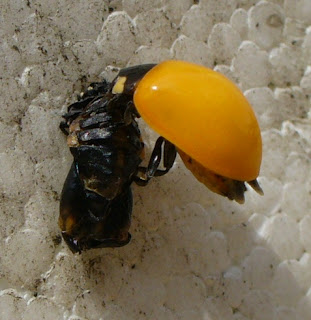Ladybirds are beetles of the family Coccinellidae, and are often split into the larger and more familar 'macro' ladybirds and the smaller microladybirds or 'inconspicuous' ladybirds. In Britain there are 47 species in total and 26 are the more typical species that I want to look at here (well, a few of them at least). The most familiar is probably the 7-spot ladybird which is large (for a ladybird) and has (on its elytra or 'wing cases') the typical pattern of black spots on a red background. However...
 |
| Teneral (recently emerged) specimen of the 7-spot ladybird |
This is a 7-spot but is yellowish rather than red as it is a newly emerged adult and its pattern has yet to develop. In fact it you looked even earlier, you'd see this:
 |
| A 7-spot ladybird just having emerged from its pupal skin |
The reason for showing these pictures, apart from being a reminder that even common things can be tricky, is to show two key features of the 7-spot:
- Black legs.
- Black pronotum (the plate between the head and wing cases) with white spots to the sides.
Features like this are important as they help distinguish species from each other even when the spot pattern is abnormal (which does happen - spots can be fused, increased in number or missing). There is a Scarce 7-spot which is very similar but has two pairs of tiny white triangles underneath (by the hind and middle legs) while the 7-spot has a single pair (by the middle legs).More commonly however, the 7-spot needs to be distinguished from the Harlequin ladybird.
 |
| Harlequin ladybird |
The Harlequin is well-known as an invasive non-native species that has spread rapidly across Britain since its arrival from Asia in 2003. It is often found hibernating in buildings and evidence has started to be found of its impact on native species such as the 2-spot, through competition for food and by direct predation of eggs and larvae. The Harlequin is highly variable (see here for the range of patterns) though the one above is commonly seen. You can see that the legs are paler than those of the 7-spot, and the pronotum is more extensively white with a black M (or W) shaped mark. Easy!
That's all I want to cover for now - more coming soon. If this is a subject that interests you, there is a UK Ladybird Survey for all abilities where you can send in records of your sightings which all helps understanding the dynamics and ecology of one of our most popular groups of insects.
Further reading
Majerus, M. & Kearns, P. (1989). Ladybirds. Richmond, Slough. An excellent little book with detailed keys to species, including the 'micros' - a new edition is being prepared.
Majerus, M., Roy, H., Brown, P. & Ware, R. (2006). Guide to Ladybirds of the British Isles. FSC, Preston Montford. A fold-out laminated sheet perfect for beginners.
Roy, H., Brown, P., Frost, R. & Poland, R. (2011). Ladybirds (Coccinellidae) of Britain and Ireland. FSC, Shrewsbury. Details of all species including maps, identification features, ecology and so on.
Common and scientific names of species mentioned here
7-spot: Coccinella septempunctata
Scarce 7-spot: Coccinella magnifica
Harlequin: Harmonia axyridis
2-spot: Adalia bipunctata
No comments:
Post a Comment